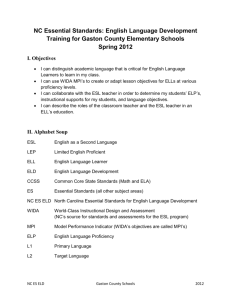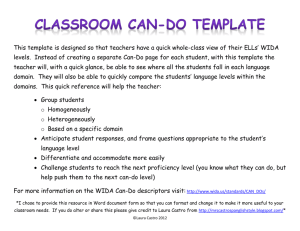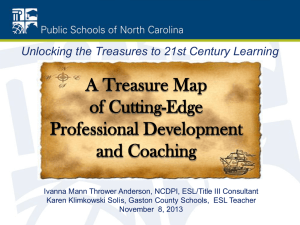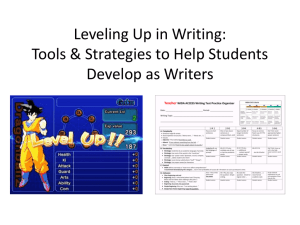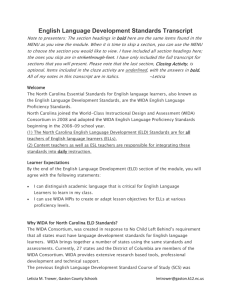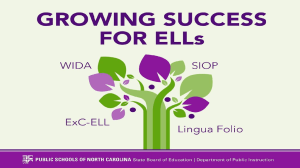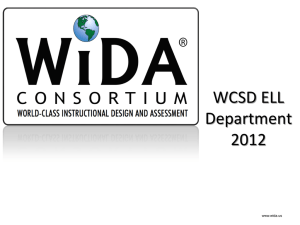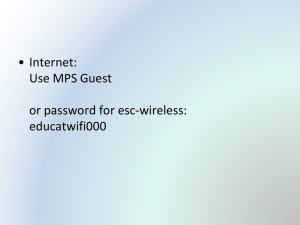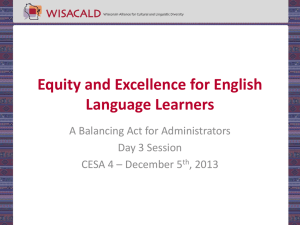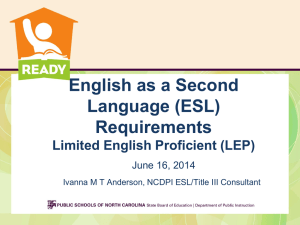WIDA Standards: Using Language Objectives to Differentiate
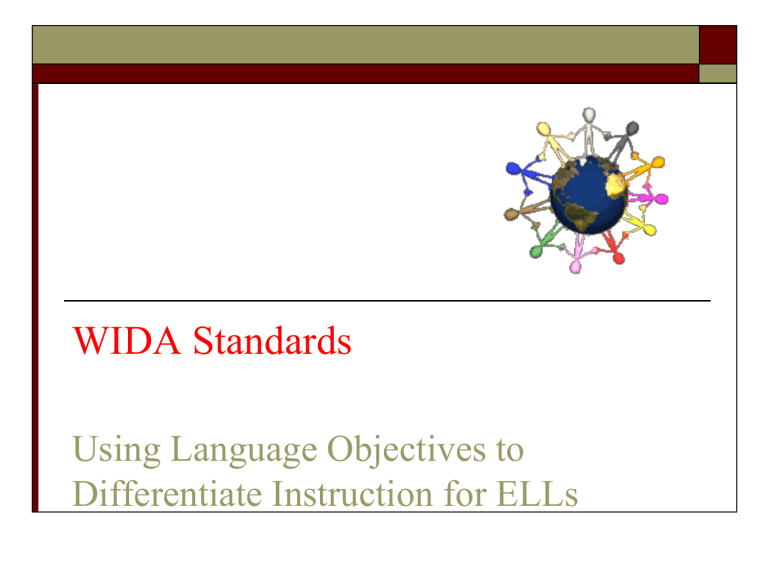
WIDA Standards
Using Language Objectives to
Differentiate Instruction for ELLs
What is WIDA?
ELD Standards (English Language
Development Standards / NC
Essential Standards)
Common Core Training with ESL Strategies
What is WIDA?
WIDA stands for World-Class Instructional
Design and Assessment
Adopted by 22 states
Visit the WIDA website: http://www.wida.us/
How can I make grade level content comprehensible for my ELLs?
What language does he need to learn ____?
What can he do?
How can he show his learning?
ACCESS scores, Can Do Descriptors, and
Performance Definitions answer these questions for us.
Why should we implement WIDA
Standards?
Mandated by the NC Dept. of Education
Used as a tool for the implementation of the Common Core State and
Essential Standards
Every teacher with ELLs needs to weave in ELD Standards in their instruction daily.
Supports the teacher!
NC Teacher Evaluation Standards II and IV
Differentiation made easy!
Assessment wall conversations will be more meaningful.
Teachers can use the language provided by WIDA to formulate measurable goals on PEPs.
Supports all ESL students!
Extends NC Falcon and the Common Core
NC Teacher Evaluation Process
Standard II: Teachers Establish a Respectful
Environment for a Diverse Population of
Students:
D.) Teacher adapt their teaching for the benefit of students with special needs. (special language needs)
NC Teacher Evaluation Process
Standard IV: Teachers Facilitate Learning for
Their Students
A.) Teachers know the ways in which learning takes place, and they know the appropriate levels of intellectual, physical, social, and emotional development of their students.
B.) Teachers plan instruction appropriately for their students.
C.) Teachers use a variety of instructional methods.
D.) Teachers use a variety of methods to assess what each student has learned.
English Language Proficiency
Standards
WIDA Standards
Gives teachers a framework to differentiate instruction.
Easily altered to fit what we are teaching
Centered on the language needs of the student to access grade level content
What are the Standards?
Standard:
Language of Math
Language Domains :
Listening
Speaking
Reading
Writing
Standards:
Language of
Science
What language do my students need to understand in order to learn the content?
Standard:
Language of
Language
Arts
Standard:
Social and
Instructional
Language
Standard:
Language of
Social
Studies
Data Driven Instruction:
Student Roster Reports
All LEP students received a language proficiency test called the ACCESS test.
This test measures English proficiency in:
Listening
Speaking
Reading
Writing
Student Roster Reports: 2011 ACCESS
Scores
Includes scores for all of the ESL students in your school last year.
See highlighted sections for specific scores.
The following slides will explain how to interpret these scores.
Language Proficiency Levels
Many of our ESL students are in this range in one or more language domains.
Students in this area are comparable to native English speakers.
Source: www.wida.us
What are the Language Proficiency
Levels?
1 Entering: minimal social and academic language with support
2 Beginning: uses some social and academic language with support
3 Developing: uses social English and SOME academic language with support
4 Expanding: uses social English and some technical academic language
5 Bridging: uses social and academic language working with grade level material
6 Reaching: uses social and academic language at the highest level
The Continuum of Second Language
Acquisition
Entering: 1 Reaching: 6
The second language acquisition process involves gradual scaffolding from:
Concrete ideas/concepts
Familiar situations
General vocabulary
Single Words & Phrases
Abstract ideas/concepts
Unfamiliar situations
Technical vocabulary
Extended discourse
Source: page RG12 WIDA Standards Booklet
What is the difference between specialized and technical vocabulary?
General
Math 1-2 in all
Specific total
Technical sum
ELA
3-5 person
Science 6-8 knee
Social
Studies
9-12 people character protagonist kneecap patella population Demographics
RG-46 Figure 5C WIDA
Resource Guide
When are students considered English language proficient?
ACCESS results are as followed to exit the
ESL program.
Reading=4.0 Expanding
Writing=4.0 Expanding
Composite (Overall Score)= 4.8
Expanding/Bridging Level
Students that exit the program are monitored for
2 years. Temporary support is given when needed.
What should we expect from our students?
Important references:
Performance Definitions
Can Do Descriptors
More about Language Proficiency
Levels:
Performance Definitions-
Describes at each level what students can process, understand, produce or use.
Refer to page RG-45 in your Resource Guide
Read and discuss characteristics of each level with your group.
Can Do Descriptors
What can my student do?
Refer to page RG 58 in your Resource Guide
BEST resource!
Helps us answers the question:
What can I expect from my students?
Using a highlighter, mark the verbs that you see on the handout.
Notice the types of verbs we use at each proficiency level.
These verbs help us create formative assessment tasks that are appropriate for a particular language level.
Now, select a student from the Student
Roster Report provided.
Using the
Can Do’s and Performance
Definitions , discuss how the rubrics can help you understand what the student can do and what we should expect them to do.
How to Create a Language
Objective
How to create a language objective:
Language Objectives have 3 parts :
Verb + Topic + Support
Creating a language objective: step-by-step
1 st
Choose a topic
2 nd
Choose a verb
Is the verb appropriate for his/her level of language?
How do I want to assess their knowledge?
3rd
Choose a method of support.
How can I help them understand the vocabulary?
Verbs are POWERFUL!
WIDA and NC FALCON
V
ERB = FORMATIVE ASSESSMENT (Differentiation)
How will the student demonstrate understanding?
Is the selected verb appropriate for the language level of my student?
Can this mode of communication (VERB) help students demonstrate what they TRULY know?
Refer to handouts that show lists of verbs in your folder.
Why give support?
Levels the language playing field
Makes challenging vocabulary understandable
Please refer to page RG-21 for types of supports across content areas.
3.E.2.2 Compare Earth’s land features
(including volcanoes, mountains, valleys, canyons, caverns, and islands) by using models, pictures, diagrams, and maps.
Level 1
Match pictures of landforms using word cards with a partner.
Level 2
Categorize landforms by their characteristics using picture cards.
Point to pictures of landforms when asked questions.
(“Which one is a mountain”)
Explain in phrases or short sentences each category with teacher support .
Level 3
Follow multistep directions to complete a model of landforms using illustrations from the text.
Level 4
Compare and contrast different landforms using the text and a Venn diagram with a partner.
Level 5
Explain physical chararacteristics of landforms using pictures and technical vocabulary from an alphabox.
Write a brief description of each landform presented in the model using words and illustrations from the text.
Summarize the similarities and differences between two landforms using a Venn diagram.
Produce an informational article about a popular landform in the world using information found on the internet.
2.RL.7
Use information gained from the illustrations and words in a print or digital text to demonstrate understanding of its characters, setting, or plot.
Learning Target
I CAN describe how a character feels using the illustrations and the text.
Criteria for Success
I WILL identify how the character is feeling using picture cards.
I WILL point out examples from the text and illustrations to support my choice.
1.RF.3b Decode regularly spelled one syllable words
Learning Target
I CAN read one syllable words.
Criteria for Success
I WILL identify each letter sound in a word using sound boxes.
I WILL produce a new word by changing the beginning sound in a word using sound boxes.
Look at all of our resources!!!!
ESL
Teachers
Verbs
Can Do’s
ACCESS scores
Performanc e Definitions
Supports
Please visit www.wida.us
for many useful resources!
ESL Website
Training materials (including this presentation) are available on our ESL website.
Questions? Need resources?
We are always available to help you!
www.wida.us
Our ESL website
Please visit our ESL website!
Please keep in touch!
